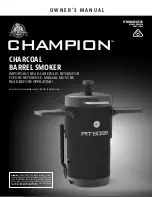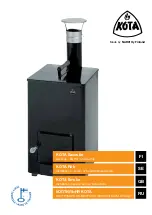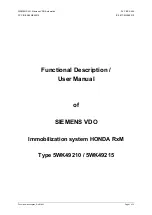
3
•
Smoke alarms can only sound their alarms when they
detect smoke or detect combustion particles in the air.
They do not sense heat, flame, or gas. This smoke alarm
is designed to give audible warning of a developing
fire. However, many fires are fast - burning, explosive,
or intentional, and others are caused by carelessness or
safety hazards. In this circs, Smoke may not remake the
unit alarm
QUICKLY ENOUGH
to ensure safe escape.
•
Smoke alarms have limitations. This smoke alarm is not
foolproof and is not warranted to protect lives or property
from fire. Smoke alarms are not a substitute for insurance.
Homeowners and renters should insure their lives and
property. In addition, it is possible for the smoke alarm to
fail at any time. For this reason, you must test the smoke
alarm weekly and replace unit every 10 years.
6.Do not install smoke alarms in the following places
•
Near appliances or areas where normal combustion regu-
larly occurs (kitchens, near furnaces, hot water heaters).
Use specialized smoke alarm with unwanted alarm
control for this areas.
•
In areas with high humidity, like bathrooms or areas near
dishwashers or washing machines. Install al least 3 m
away from these areas.
•
Near air returns or heating and cooling supply vents.
Install at least 0,9 m away from these areas. The air could
blow smoke away from the detector, interrupting its alarm.
•
In rooms where temperatures may fall below 4°C or rise
above 38°C.
•
In extremely dusty, dirty, or insect – infested areas influ-
ence particles interfere with smoke alarm operation.
7.Battery Specification
•
Rating voltage: DC 1.5V
•
Package: AA alkaline battery
•
Recommend battery:
Energize: E91
Gold Peak Group: GP 15A LR6
Raymax: LR6
7.1 Replace Battery
•
Turn the alarm body counterclockwise and take out the
alarm body from the bracket.
•
Take out the old battery from the battery box.
•
Fix the two new batteries to the battery box. Please note
the battery polarity.
•
Fix the battery into battery box, fit alarm body on bracket
and turn the alarm body clockwise.
•
Test smoke alarm using test button. The sound pattern
is 3 short beeps-1.5 seconds pause, repeat it. If there’s
no sound output, it means that the smoke alarm is faulty
or the installing operation is wrong, and you should
gain the correctly method of disposal through reading
“TROUBLE SHOOTING”.
Note
During testing, because the unit send the wireless
signal, may the other smoke detector will alarm. Once
release the test button, the other smoke detector will
stop alarming in 1 minute.
8. LED indicator
•
When the alarm is running normally, the red LED will
flash 1 time per 40 seconds.
•
When the battery failure or low battery is detected, the
alarm will “chirp” 1 time and with a corresponding red
LED flashing 1 time per 40 seconds.
•
When the unit is fault, the alarm will “chirp” 1 time per
40 seconds.
•
When the unit is running in the silence mode, the red
LED will flash once every 8 seconds.
Note
When the units chirp 1 time per 40 second, Press the
test button, it will be paused for this warning tone for
8 hours. It can still normally detect smoke during this
period, it only remove nuisance warning tone.
9. Alarm silence (silence mode)
During the unit is alarming, push the test button, it will be
paused the unit alarming for approx 10 minutes. The red
LED will flash once every 8 seconds, it indicates the smoke
alarm is running into the silence mode. Smoke alarms
are designed to minimize nuisance alarms. Combustion
particles from cooking may set off the alarm if the alarm
is located close to the cooking area. Large quantities of
combustible particles are generated from spills or when
grilling/frying. Using the fan on a range hood that vents to
outside (non-recirculating type) will also help remove these
combustible particles from the kitchen. The alarm silence
(test button) is extremely useful in a kitchen area or other
areas prone to nuisance alarms.
The silence feature is to be used only when a known alarm
condition, such as smoke from cooking activates the alarm.
The smoke alarm will automatically reset after approximate-
ly 10 minutes, if after this period, particles of combustion
are still present, the alarm will sound again.
The alarm silencer (silence mode) can be repeatedly until
the air has been cleared of the condition causing the alarm.
10. Testing the Smoke Alarm
Test each smoke alarm to be sure it is installed correctly
and operating properly.
•
Do not use an open flame to test the alarm. You may
ignite and damage the alarm or your home.




































